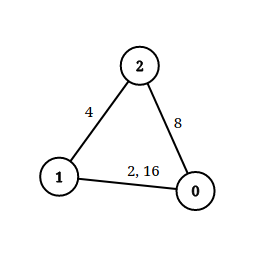2023-04-29 Daily Challenge
Today I have done leetcode's April LeetCoding Challenge with cpp.
April LeetCoding Challenge 29
Description
Checking Existence of Edge Length Limited Paths
An undirected graph of n nodes is defined by edgeList, where edgeList[i] = [ui, vi, disi] denotes an edge between nodes ui and vi with distance disi. Note that there may be multiple edges between two nodes.
Given an array queries, where queries[j] = [pj, qj, limitj], your task is to determine for each queries[j] whether there is a path between pj and qj such that each edge on the path has a distance strictly less than limitj .
Return a boolean array answer, where answer.length == queries.length and the jth value of answer is true if there is a path for queries[j] is true, and false otherwise.
Example 1:

Input: n = 3, edgeList = [[0,1,2],[1,2,4],[2,0,8],[1,0,16]], queries = [[0,1,2],[0,2,5]] Output: [false,true] Explanation: The above figure shows the given graph. Note that there are two overlapping edges between 0 and 1 with distances 2 and 16. For the first query, between 0 and 1 there is no path where each distance is less than 2, thus we return false for this query. For the second query, there is a path (0 -> 1 -> 2) of two edges with distances less than 5, thus we return true for this query.
Example 2:

Input: n = 5, edgeList = [[0,1,10],[1,2,5],[2,3,9],[3,4,13]], queries = [[0,4,14],[1,4,13]] Output: [true,false] Exaplanation: The above figure shows the given graph.
Constraints:
2 <= n <= 1051 <= edgeList.length, queries.length <= 105edgeList[i].length == 3queries[j].length == 30 <= ui, vi, pj, qj <= n - 1ui != vipj != qj1 <= disi, limitj <= 109- There may be multiple edges between two nodes.
Solution
auto speedup = [](){
cin.tie(nullptr);
cout.tie(nullptr);
ios::sync_with_stdio(false);
return 0;
}();
class Solution {
vector<int> parent;
int curIndex;
void init(int n, vector<vector<int>>& edgeList) {
curIndex = 0;
sort(edgeList.begin(), edgeList.end(), [](const vector<int>& a, const vector<int>& b) {
return a[2] < b[2];
});
parent.resize(n);
for(int i = 0; i < n; ++i) {
parent[i] = i;
}
}
int find(int x) {
if(parent[x] != x) parent[x] = find(parent[x]);
return parent[x];
}
void merge(int x, int y) {
int px = find(x);
int py = find(y);
parent[px] = py;
}
void solveToLength(int len, vector<vector<int>>& edgeList) {
for(; curIndex < edgeList.size() && edgeList[curIndex][2] < len; ++curIndex) {
merge(edgeList[curIndex][1], edgeList[curIndex][0]);
}
}
public:
vector<bool> distanceLimitedPathsExist(int n, vector<vector<int>>& edgeList, vector<vector<int>>& queries) {
init(n, edgeList);
int len = queries.size();
vector<int> order(len);
vector<bool> answer(len);
for(int i = 0; i < len; ++i) {
order[i] = i;
}
sort(order.begin(), order.end(), [&](int a, int b) {
return queries[a][2] < queries[b][2];
});
for(auto i : order) {
solveToLength(queries[i][2], edgeList);
answer[i] = (find(queries[i][0]) == find(queries[i][1]));
}
return answer;
}
};
// Accepted
// 23/23 cases passed (476 ms)
// Your runtime beats 98.73 % of cpp submissions
// Your memory usage beats 84.81 % of cpp submissions (109.6 MB)